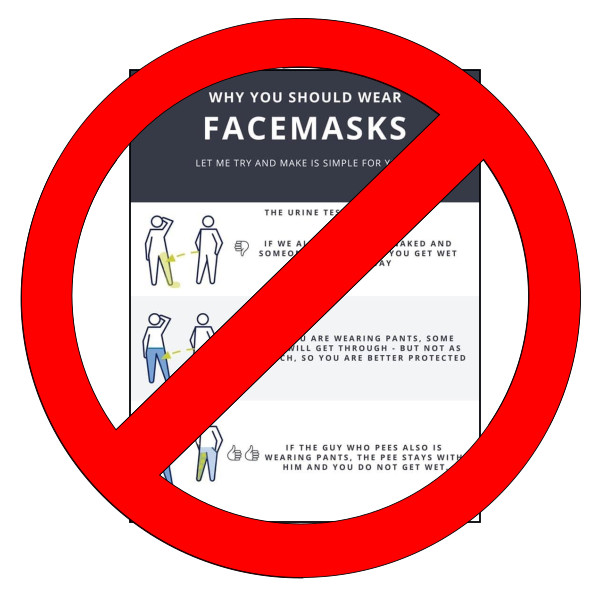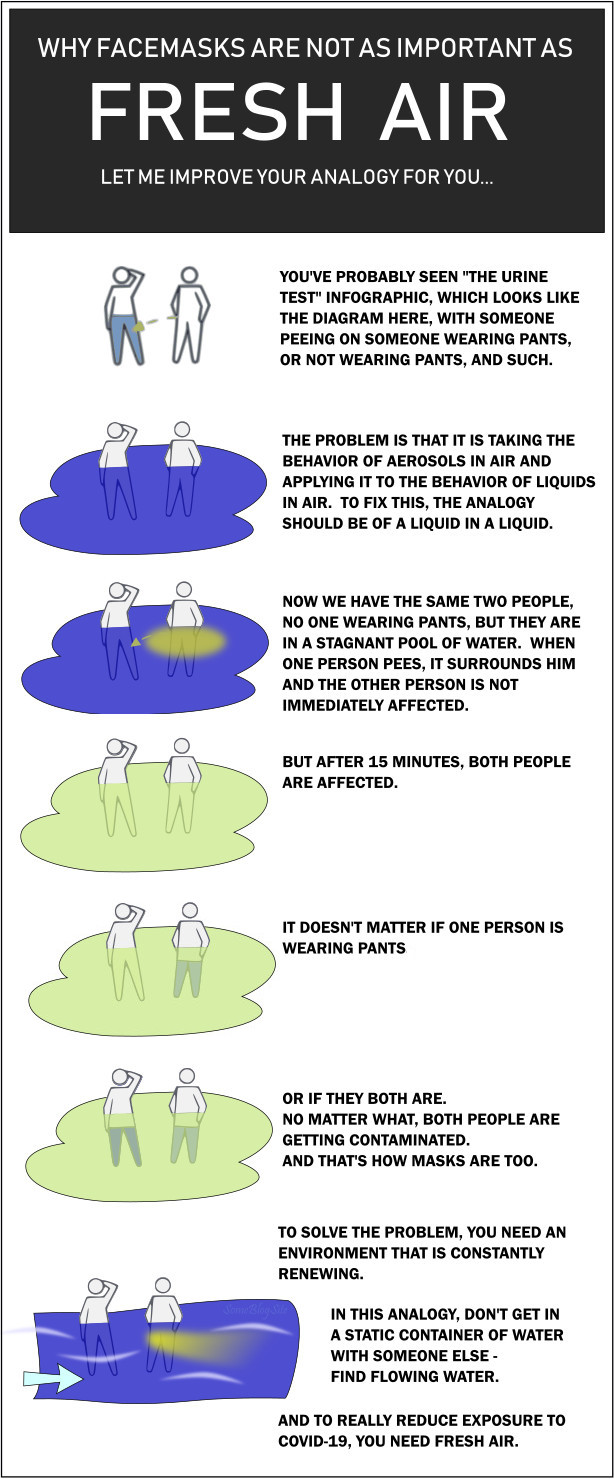Mask Analogy, Updated
Jan
6
2021
There is a certain infographic that made its rounds a while ago and was a popular way for people to describe why it’s important for everyone to wear a mask.
But the analogy bothered me.
First of all, I didn’t like it because it was crude and used urine to make a point. Not what I wanted to work with, but that is what the internet has served up.
Second of all, I didn’t like the attitude with which it was presented.
Third of all, it’s wrong.

It might have been right at the time it was made, based on what was known then. But now that we know more, it’s time to update the analogy.
Of course, all analogies break down at some point. None of them can be perfect, otherwise it would be the exact situation and no longer an analogy. But this one is wrong because it does not properly characterize the behavior of a fluid in its medium.
Let’s start with some sources, for those of you who like citations.
The model that piqued this blog post
and support from the BBC
and from NPR.
Here is my take on the analogy, what it should be to more reflect reality:

I’m not a fan of masks, but I wear it in a store that requires it – I don’t want to cause trouble. This post is not here to cause trouble, but rather prevent it – let people know they’re concentrating on the wrong thing if they’re promoting masks instead of fresh air. Actually, I just wanted to fix what I saw wrong with that original analogy poster, but now I’m in typing mode so I’m going to elaborate a bit.
I think masks was the first thing that got traction as a mitigation method, and now it has stuck as common knowledge. Plus it’s easy for people to see and enforce, and now it’s entrenched in corporate policy. I’m thinking companies will be very reluctant to remove mask wearing as a policy because it would open them up to liability (“They did not follow best practices and I got sick…” even though a mask is not the best practice but since everyone is doing it, it is called a best practice). But just because it’s common knowledge does not mean it’s right, or the best thing. Like I’ve mentioned before with the foolishness of crowds, common knowledge can be wrong.
It is not so easy to see and enforce a minimum rate of fresh air exchanges in buildings, but that is more effective than masks. But masks are so ingrained in people as THE solution for preventing coronavirus that it will be an uphill battle trying to remove them.
The reports I’ve seen so far, and nurses I’ve talked to, indicate that masks will still be required even for people who have the vaccine. But masks are not as effective as fresh air. I would much rather be in a building with a good air exchange rate and no masks than in a building with no fresh air and everyone wearing masks. But which standard is our local government pushing? Masks.
What I would like is that any businesses could open and allow the public in if the building has been certified to have a good enough air exchange rate. And people who are fully committed to wearing masks could keep wearing their masks, but those of us who trust fresh air more than masks would be free to frequent like-minded establishments. And in a perfect world, the air flow would be directed down, so aerosols would not be spread laterally. That’s what makes being outside good – the air flow is not in a constant sideways direction. If you’re next to someone outside, the air is changing and swirling.
One point that needs to be made is that it needs to be fresh air, not recirculating air. If you just set the fan on your HVAC to On instead of Auto and think you’re good, that won’t work. Going back to the analogy, it would be like being in a lazy river (rather than an actual river) with other people: sure, contaminants will be diluted, but they’re not going away. Your building’s HVAC needs to bring in outside air.
And that could explain why people who are quarantining in certain situations still got COVID even though they did what they were supposed to do. People in nursing homes being stuck in their room for weeks, even months (to “keep them safe”), got COVID because their building had a central air system. Even though people weren’t going in and out of rooms, or even between floors, the contaminated air got spread throughout the whole building.
It does also work for airplanes. Airplanes do bring in fresh air constantly – no recirculation of stale air in there. The air comes in the system, through the nozzles, and goes out the back. So you are safe in an airplane, probably better than most brick-and-mortar establishments currently, but keep that air nozzle on full and pointed at you. If you turn that off and sit in the back of the plane, you’re getting the worst of it.
Final point, in keeping with the airplane theme: Wearing masks is like taking your shoes off at the airport – it doesn’t really make flying any safer but we have to do it because it was an early policy that stuck and it looks like we’re doing something.
For this time I am going to send all My plagues on you and your servants and your people, so that you may know that there is no one like Me in all the earth.
Exodus 9:14




This little article thingy was written by Some Guy sometime around 6:23 am and has been carefully placed in the Current Events category.

 This is Alpha, the first-born, when he was 2YO.
This is Alpha, the first-born, when he was 2YO. This is Beta, the second-born, when he was about 2YO.
This is Beta, the second-born, when he was about 2YO. This is Gamma, the third-born, when he was about 18MO.
This is Gamma, the third-born, when he was about 18MO.


January 6th, 2021 at 10:43 am
I heartily endorse this post. Thank you.
January 13th, 2021 at 2:58 am
Driving across the country has been interesting. Some places aggressively push masks. In West Texas, though, it might not be too far in the future where wearing a mask will get you roughed up. With how much wide open space they have there, it sounds like they’re taking the right approach.